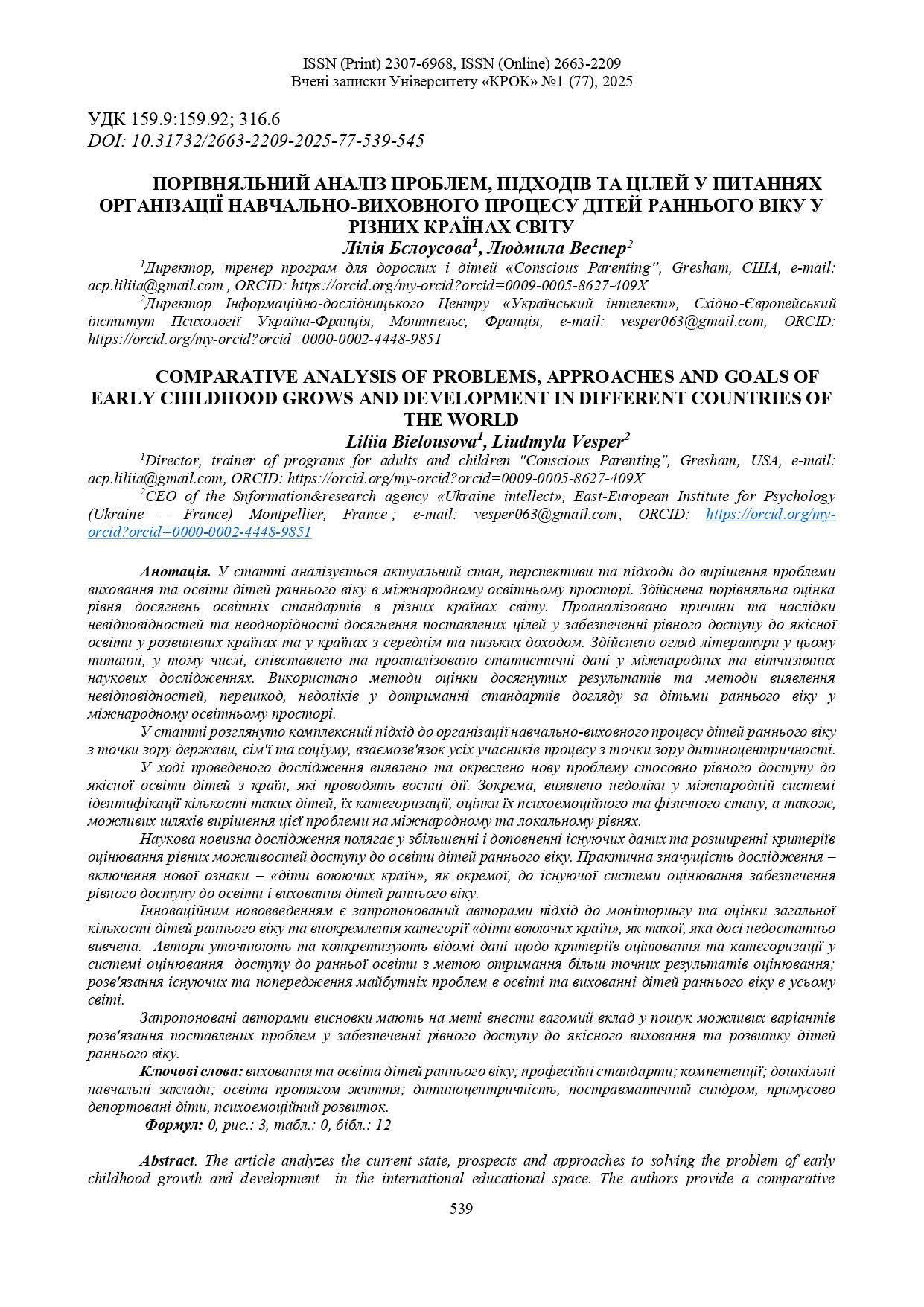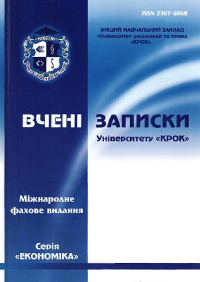COMPARATIVE ANALYSIS OF PROBLEMS, APPROACHES AND GOALS OF EARLY CHILDHOOD GROWS AND DEVELOPMENT IN DIFFERENT COUNTRIES OF THE WORLD
DOI:
https://doi.org/10.31732/2663-2209-2025-77-539-545Keywords:
early childhood grows and development, professional standards, professional competences, early childhood educator, preschool, continuous learning; human-centeredness, post-traumatic stress disorder, forcibly deported children, psycho-emotional developmentAbstract
The article analyzes the current state, prospects and approaches to solving the problem of early childhood growth and development in the international educational space. The authors provide a comparative assessment of the level of achievements of educational standards in different countries. They analyze the causes and consequences of discrepancies and heterogeneity in achieving the goals set in ensuring equal access to quality education in developed countries and in countries with middle and low incomes. A literature review is conducted on this issue, including comparing and analyzing statistical data in international and domestic scientific research. The paper scrutinizes methods for assessing the achieved results and methods for identifying discrepancies, obstacles, and shortcomings in complying with standards for caring for young children.
The article considers a state, family and society comprehensive approach to organizing the early grows and development, and the relationships of all participants assumed as a child-centeredness.
The article identified and outlined a new problem regarding equal access to quality education for children from countries engaged in war. In particular, shortcomings were identified in the international system for identifying the number of such children, their categorization, assessment of their psycho-emotional and physical condition, as well as possible ways to solve this problem at the international and local levels. The conclusions proposed by the author are intended to make a significant contribution to the search for possible solutions to the problems posed in ensuring equal access to quality growning and education for early childhood.
Downloads
References
Кремень, В.Г. (2021). Освіта дітей раннього та дошкільного віку в контексті їх безперервного розвитку.
DOI: https://doi.org/10.37472/2707-305X- 2021-3-2-1-1
Основні освітні статистичні дані 2023-2024 н.р. (2025). Інститут освітньої аналітики. https://iea.gov.ua/diyalnist/naukovo-analitichna-diyalnist/osnovni- czyfry-osvity/
Benard Omenge Nyatuka, & Patrick Odiwuor Abuom M. ( 2018). Teacher Factors in the Management of Early Childhood Development and Education for Quality Education in Kenya. https://www.researchgate.net/publication/351424410_Teacher_Factors_in_the_Management_of_Early_Childhood_Development_and_Education_for_Quality_Education_in_Kenya
Benard Omenge Nyatuka (2018). Comparative Study of Teacher Qualification and Staffing in Public Pre-Schools: A Case of Selected Counties in Kenya. International Journal of Recent Research in Social Sciences and Humanities (IJRRSSH)Vol. 5, Issue 2, 14-23. www.paperpublications.org
Children, Youth and Developmental Science in the 2015–2030. (2017). Society for research in child development. Global Sustainable Development Goals, 30(3). https://files.eric.ed.gov/fulltext/ED581660.pdf
Early childhood care and education working papers series. (2015). A Review of the literature: early childhood care and education (ECCE) personnel in low- and middle-income countries., Corporate author: Results for Development Institute (USA), 7-11; 21-23. https://unesdoc.unesco.org/ark:/48223/pf0000234988
Early childhood education statistics. Statistics Explained by Eurostat, official website of the European Union. (2024). https://ec.europa.eu/eurostat/statistics-explained/index.php?title=Early_childhood_education_statistics
Maureen M. Black, Susan P. Walker, Lia C. H. Fernald, Christopher T. Andersen, Ann M. DiGirolamo, Chunling Lu, Dana C. McCoy, Günther Fink, Yusra R. Shawar, Jeremy Shiffman, Amanda E. Devercelli, Quentin T. Wodon, Emily Vargas-Barón, & Sally Grantham-McGregor. (2016). Early childhood development coming of age: science through the life course. https://pubmed.ncbi.nlm.nih.gov/27717614/
Statistics Explained by Eurostat , official website of the European Union. (2013). https://ec.europa.eu/eurostat/statistics-explained/index.php?title=International_Standard_Classification_of_Education_(ISCED)
International Standard Classification of Education (ISCED), UNESCO Institute of statistics (2013). https://uis.unesco.org/en/topic/international-standard-classification-education-isced
US Department of Education: EDUCATION IN THE USA ОСВІТА У США https://www.openworld.gov/uploadedfiles/education_in_the_usa-ukr.pdf
Vesper, L. L. (2024). Application of the pattern mathod to form the neural structures in the learning process as a way of solving modern problems in education. DOI: https://doi.org/10.52058/2695-1592-2024-4(35)-261-269

Downloads
Published
How to Cite
Issue
Section
License

This work is licensed under a Creative Commons Attribution-NonCommercial 4.0 International License.

